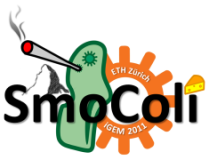Team:ETH Zurich/Modeling/SingleCell
From 2011.igem.org
(→Brief overview of the model) |
|||
| Line 2: | Line 2: | ||
[[File:Singlecellmodel.PNG|867px|center|Single cell model]] | [[File:Singlecellmodel.PNG|867px|center|Single cell model]] | ||
| - | |||
| - | |||
=Brief overview of the model= | =Brief overview of the model= | ||
| + | |||
| + | The model of our system consists of two connected parts: the band detector and the toggle switch. The band detector produces green fluorescent protein upon a detection of a certain range (band) of acetaldehyde concentration. After acetaldehyde concentration passes a certain threshold the toggle switch turns the system red (red fluorescent protein is expressed). | ||
Acetaldehyde from the smoke binds to AlcR and the formed complex then inhibits TetR. TetR inhibits LacI and CI. CI also inhibits LacI which inhibits GFP. This part of the circuit makes up the band detector. The Acetaldehyde-AlcR complex is considered as constant input to our system. By simulating with varying acetaldehyde concentrations we can see at which concentration is the band , i.e. at which concentrations GFP is produced. The connection to the switch is the LuxI inbition by CI. LuxI in turn produces AHL, which is described in our model as two states (AHL external and AHL internal). AHL diffuses in and out of the cell and after binding of AHL internal to LuxR, the complex R is created. In the model the LuxR concentration is taken as a parameter since it does not vary with time. Finally, RFP is inhibited by the complex R. | Acetaldehyde from the smoke binds to AlcR and the formed complex then inhibits TetR. TetR inhibits LacI and CI. CI also inhibits LacI which inhibits GFP. This part of the circuit makes up the band detector. The Acetaldehyde-AlcR complex is considered as constant input to our system. By simulating with varying acetaldehyde concentrations we can see at which concentration is the band , i.e. at which concentrations GFP is produced. The connection to the switch is the LuxI inbition by CI. LuxI in turn produces AHL, which is described in our model as two states (AHL external and AHL internal). AHL diffuses in and out of the cell and after binding of AHL internal to LuxR, the complex R is created. In the model the LuxR concentration is taken as a parameter since it does not vary with time. Finally, RFP is inhibited by the complex R. | ||
Revision as of 15:46, 6 September 2011
Brief overview of the model
The model of our system consists of two connected parts: the band detector and the toggle switch. The band detector produces green fluorescent protein upon a detection of a certain range (band) of acetaldehyde concentration. After acetaldehyde concentration passes a certain threshold the toggle switch turns the system red (red fluorescent protein is expressed).
Acetaldehyde from the smoke binds to AlcR and the formed complex then inhibits TetR. TetR inhibits LacI and CI. CI also inhibits LacI which inhibits GFP. This part of the circuit makes up the band detector. The Acetaldehyde-AlcR complex is considered as constant input to our system. By simulating with varying acetaldehyde concentrations we can see at which concentration is the band , i.e. at which concentrations GFP is produced. The connection to the switch is the LuxI inbition by CI. LuxI in turn produces AHL, which is described in our model as two states (AHL external and AHL internal). AHL diffuses in and out of the cell and after binding of AHL internal to LuxR, the complex R is created. In the model the LuxR concentration is taken as a parameter since it does not vary with time. Finally, RFP is inhibited by the complex R.
Our model has 9 states in total and 37 parameters, including the Acetaldehyde-AlcR input and LuxR. Basal expression is considered for none of the states and linear degradation is considered for all of them.
 "
"




